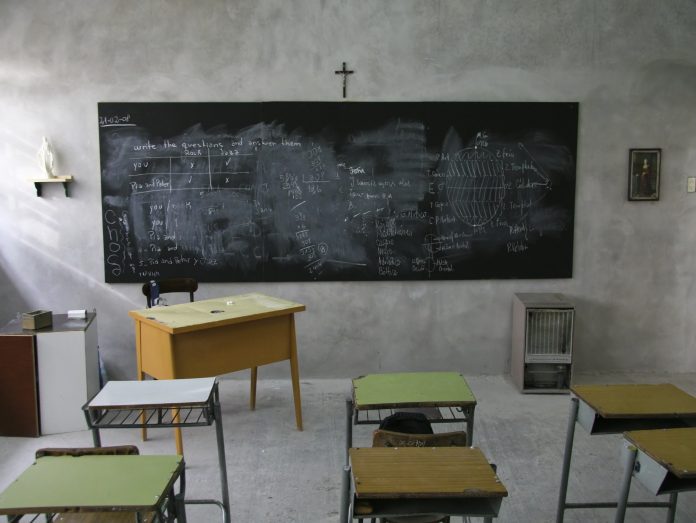
by Lee Danesco
Feel the excitement in the air? Sense the anticipation?
Pre-season training is just about over, so review your strategies and summon your enthusiasm. It’s time to kick off this year’s catechetical season.
For religious education teachers, meeting a new group of children provides a fresh and exciting opportunity to lay a solid foundation for the year ahead. The way in which your students experience you for the first time can make a powerful and lasting impact that will lead them enthusiastically forward into the months ahead.
To guarantee that the first impression you make on your class is a positive one, you will want to do more than call the roll and share a few pages of text. You will want to present yourself and the lesson in ways that will convince students that they are receiving important and exciting information from a competent and caring faith leader in an atmosphere of mutual respect and trust.
Your task during those precious first sessions will be to assure the children of a safe and secure haven where together you can share and give reverence to the Good News of Jesus Christ. So your task before those sessions is to find the words and approaches that will allow you to provide an inspiring first connection with your students and a successful kickoff for the year ahead.
The First Class
Even though you may not know a single child in your new class, you can assume this about any group of students: They expect a standard teaching routine but they love surprises!
Knowing this, an introductory lesson like the one that follows accomplishes familiar and necessary tasks and uses an unexpected and interactive approach to achieve those tasks.
Preparation
1. Write each student’s name at the top of an index card. Band the cards together and set them aside.
2. Cut sheets of copy paper into quarters and on each quarter sheet, write “Student name” followed by a blank line, and “Teacher name” followed by a blank line. Then list group behaviors that will serve as the Class Code of Conduct, which might look like this:
Our Class Code of Conduct
Student Name: ______________
Teacher Name: ______________
1. I will love God and neighbor.
2. I will show my love by treating everyone with kindness.
3. I will raise my hand when I wish to speak.
4. I will bring this book with me to each class session.
Attach one of these sheets to the inside cover of each textbook.
3. Write each child’s name on a small slip of paper and place the slips in a bag.
4. Arrange a prayer table with a seasonal covering, a Bible, textbooks, pencils, the stack of index cards bearing the students’ names, the bag containing the students’ names, and an unlit candle.
Welcome
As students arrive, give each one his or her name card from the prepared stack. Invite them to take any seat they wish and to place their name card name side down on the desk. When all students have arrived, share a general welcome, noting that some students may already know one another but others may not. Invite students to share in the following opening activity that encourages everyone to speak, move, and learn the name of at least one other classmate.
1. Draw a slip from the bag of names and read aloud the student’s name. This student will serve as the “first player.” Ask that student to come to the front of the room, bringing his or her name card. Explain that he or she is about to receive a new seat.
2. Have the “first player” draw another slip from the bag and read aloud the student’s name. That person, the “second player,” comes to the front of the room, bringing his or her own name card.
3. The “first player” goes to the “second player’s” seat and sits down, placing his name card name side up on the new desk.
4. The “second player” then draws another slip from the bag, reads aloud the student’s name, and the process is repeated. Continue until all names have been read. The last participant named can claim any empty seat.
Prayer
Introduce the opening prayer by collecting student name cards and reading names aloud as you move from desk to desk. Band cards and replace them on the prayer table next to the textbooks. Establish a prayerful quiet, light the candle, and center your opening prayer on the class community, its tools, and its learning goal.
1. Explain that you expect everyone to work together during the year to know God better and to serve him more faithfully.
2. Describe the books on the table (textbooks and Bible) as important tools to be used in that effort throughout the year.
3. Pray: “Almighty Father, help us to work together with respect for one another. Help us to make good use of our books and class time, as we learn to love and serve you and our neighbor in all we say and do.”
4. Invite students to say, “Amen.”
Code of Conduct and Expectations
Pass out the textbooks and pencils. Instruct students to open books to the inside cover and to fill in their names and your name (spell your name on the board) in the appropriate blanks on the attached sheet. Against the background of your opening prayer—about loving God and neighbor—discuss the Class Code of Conduct attached to the inside cover of the text.
1. Emphasize that what you expect of them in the weeks to come—no matter what the lesson, the activity, or the situation—is summed up in the simple command to love God and neighbor.
2. Review program and building rules like location and use of restrooms, dismissal time, safety rules, fire drill routes, etc.
3. Having reviewed your Class Code of Conduct, surprise and challenge students by asking them to work in small groups to list what they expect from you as their religious education teacher. Discuss their expectations as time allows and include them in your Class Code of Conduct.
Getting It Done
You should be pleasantly surprised to discover that while completing the activities above you:
* introduced yourself and all members of the class to one another
* took attendance (undistributed name cards represent absentees)
* shared prayer time as a class
* observed student personalities
* presented basic behavior guidelines
* stressed love of God and neighbor
* allowed children opportunities to move about and talk
* showed interest in and respect for student opinions
* provided for direct interaction among students, and most likely…
* made a positive first impression on your students
Conclude this introductory session with a prayer that celebrates what you can accomplish working together in this setting, something like, “Almighty Father, thank you for bringing us together with old friends and new ones. Help us to show kindness, patience, and respect for one another, especially here in this sacred space. Continue to bless us all with the desire to know, love, and serve you now and forever.” Invite students to say, “Amen.”
(If you are expected to present a lesson from your textbook during this first session, trim these activities accordingly and refer to the lesson-plan discussion that follows.)
The Second Class
Moving on to the second class session means preparing a textbook lesson that is welcoming, interesting, and meaningful. By confidently delivering an engaging lesson, you can affirm the successful kickoff of the new teaching year.
Standing by to help make that happen are your parish DRE and a teacher’s text or guide. Both will promptly and correctly explain that using a lesson plan is an essential first step to successful teaching.
Excellent lesson plans are included in most teacher guides to help you navigate your way productively through each lesson, and seldom are they as complex as they might appear. Like a good story, most lesson plans are made up of three parts: beginning, middle, and end. While the authors of the guides may use their own particular names for these parts, they generally follow this pattern:
Beginning (or Introduction, Welcome, or Preparation): This includes an opening prayer and a brief overview or focusing activity.
Middle (or Core, Teaching, or Content): This develops and explores central lesson concepts through shared reading, discussion, and activities.
End (or Conclusion, Summary, or Review): Through games, activities, and prayer, this condenses lesson experiences into easy-to-retain phrases or images.
Sample Lesson Plan for the Second Class
A lesson plan for the second class session can be divided in this same way.
Beginning: Repeat the welcoming activity used during the first session. When everyone is re-seated, alter the activity by using variations of your own creation or one of the two suggestions presented here.
* Collect all the student name cards and then challenge student volunteers to name every student in the class or just the boys or just the girls. Or work against the clock.
* Instead of collecting the name cards, ask students to use available space on the card to answer three defining questions about themselves: What’s your favorite color? What’s your favorite sport? What’s your favorite food? Then collect the cards, noting that you will use these “favorites tags” to create groups for student activities in the future.
* Refashion the opening prayer from the first session as seems appropriate.
Middle: No matter what grade level you teach or the topic you are scheduled to teach during the second session (and beyond), closely follow the lesson plan provided in your teacher guide. The plan and accompanying activities are prepared by religious education professionals with years of academic and practical experience. The content is approved and authorized by Church leadership because it reliably reflects the authentic teachings of the Church. Teamed with the on-site assistance of the DRE, the teacher guide relieves you of the need to create your own lesson plan substance and teaching sequence. Teacher guides invite you into the process by helping you share the content of the text through the prism of your unique skills and faith experiences.
End: Fill the final 5 to 10 minutes of class time with easy and fun exchanges that lead students to express or review their understanding of the day’s lesson. Your teacher guide offers ideas for this activity. Here are other suggestions:
* Write key words from the lesson on the board and ask students to illustrate or symbolize the meaning of any one.
* Have children work in pairs to come up with 5 to 10 words that explain the content of the lesson. Share similarities and differences among the lists and make a composite class list.
* Have children prepare several sentences that could be used to explain the day’s lesson to an absent child. Invite children to share their sentences.
Bringing the results of these concluding efforts to your dismissal prayer allows children to reflect once more on the heart of the lesson, giving them an opportunity to linger over their new understanding when they leave the room.
After the Kickoff
The kickoff at a football game is that exciting moment when all attention is focused on the actions of a single player on the field. With practiced precision, the kicker advances and makes powerful contact with the football. As he does, he understands that, although the kickoff is important, it is just a simple meeting of toe with ball, and only the beginning of a long game. So he looks intently downfield and watches the play develop. Someone picks up the football and runs with it, while others help clear the runner’s path as he weaves his way toward the goal.
Kicking off the religious education season is not unlike a football kickoff. It’s a beginning, an important one—but it’s just the beginning. When you kick off the learning year, you will work hard to make the first sessions compelling and enjoyable. You’ll try to make a positive impression.
Then, after your kickoff, don’t forget to look downfield. There you’ll see your students gather up the lesson and run with it, but they won’t be alone. They will be assisted by their parents and their parish family who are ready, willing, and able to offer encouragement and support as they progress in knowledge of the Catholic faith.
Enriched and strengthened by the combined talents and abilities of teachers, parents, and parishioners, children can and will run down the field of life and reach that all important goal—a life of loving and serving God and neighbor. A great kickoff can help!
Lee Danesco holds a Master of Arts degree in teaching from Brown University. She has served as a DRE and a pastoral associate, and she is a published author. Her first book, Planning a Youth Service Week, was published by Twenty-Third Publications in 2001. The Confident Catechist was published by Saint Mary’s Press in 2007.
Copyright 2012, Bayard, Inc. All rights reserved. This article is protected by United States copyright and other intellectual property laws and may not be reproduced, rewritten, distributed, redisseminated, transmitted, displayed, published or broadcast, directly or indirectly, in any medium without the prior written permission of Bayard, Inc.
This article was written by the Catechist Staff and appeared in Catechist magazine, August 2012.
Image Credit: Shutter Stock 36076513




